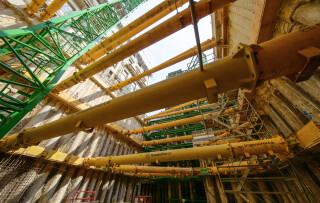It’s in the very nature of façade retention schemes that passers-by seldom have much idea of what’s going on behind the fragile façade, beyond what they can glimpse through its vacant window openings.
Such projects are fairly commonplace, especially in our city centres where preservation of the historic architecture is a priority. But these are invariably also complex jobs that demand a high degree of structural design and engineering.
They don’t come much more complex and demanding than the redevelopment of Cambridge House on Piccadilly – right in the heart of London’s West End.
Cambridge House is a Grade I listed former townhouse built in the mid-18th century for the Duke of Cambridge, the seventh son of King George III.
Occupying a prominent position on the corner of Piccadilly and Half Moon Street, the building operated as the Naval & Military Club from 1865 to 1999. During this time, the site became known colloquially as the “In & Out Club” due to the prominent gatepost signs directing vehicles through the courtyard at the front of the building.
Cambridge House is now at the centre of a technically ambitious scheme by developer Motcomb Estates to create a new hotel and associated private residences. In addition to Cambridge House itself, the site incorporates 90-93 and 95 Piccadilly (both Grade II listed) and the Grade I listed 94 Piccadilly, 42 Half Moon Street and 10-12 White Horse Street.
The development will combine these structures into three new buildings erected above multi-level basements behind the retained facades. It also includes a new five-storey extension to 12 White Horse Street.
The extensive L-shaped basement excavation poses numerous challenges. It is formed within a secant-piled retaining wall constructed around the perimeter of the site with the original facades retained along two elevations. This means that the bespoke steelwork supporting the fragile facades is assembled above the 20m-deep basement void.
The main contractor for this project is Deconstruct, a highly-specialised enabling-works contractor focusing almost exclusively on projects such as this one in central London, where it is headquartered.
The company’s involvement with Cambridge House dates back to 2018, shortly after the building, which had lain empty for almost 20 years, was acquired by brothers David and Simon Reuben for redevelopment. Years of neglect had resulted in widespread deterioration of the structure and Deconstruct’s first task was to erect a temporary roof to keep the weather out.
Deconstruct was subsequently appointed to carry out the enabling works which involve the demolition of the interior and retention of the elegant façades, plus the excavation and construction of huge basements extending down as much as four levels.
The fact that the basement excavation extends right up to the site boundary means that considerable support is required to stabilise the secant-pile retaining walls and prevent any differential movement.
This support has been supplied by specialist hire company Groundforce Shorco in the form of its modular hydraulic props, braced against waling beams installed around the perimeter of the excavation (see Proper Job).
Deconstruct installed its own bespoke steelwork for the façade retention system – and this was no straightforward task. For in addition to the façades themselves, the steel has to support the building’s grand cantilevered stone staircase inside the building – or, rather, inside where the building used to be, since everything except the staircase has been removed.
“We designed and fabricated all the steelwork,” says Deconstruct’s project director Mark Makinson. “This is what we do, except this is the biggest job of this kind that we’ve ever done.” Deconstruct also installed a special steel gantry platform to carry a 360o excavator equipped with a 20m-long telescopic boom to remove spoil from the excavation.
The staircase on its own has no structural integrity – Makinson describes it as being like a ‘giant Jenga tower’ – and so it is enveloped in a rigid steel frame tied into the steelwork supporting the façades.
But the staircase starts at ground-floor level and currently there is no ground floor – just a 20m-deep void. Vertical, as well as lateral, support was therefore required.

“We used our own mini-piling rig inside the building to install fourteen 26m-long concrete piles to support the staircase,” says Makinson. Then, as the excavation progressed, steelwork comprising three levels of heavy trusses was installed beneath the staircase to complete the rigid framework. “We’ve got 250 tonnes of steel underneath the whole thing,” says Makinson.
“We also installed hydraulic jacks underneath the frame to take out any clay heave,” he adds. “We pumped them to 50% of their stroke to give us adjustment in both directions, but we haven’t had to adjust them at all so far – there’s been no movement,” he explains.
Nobody walking past the site on Piccadilly would have any idea that, just the other side of the pavement, there was a yawning void – still less that there was a Grade I-listed stone staircase hovering in mid-air. Most of the original façade remains in place, concealing the huge transformation taking place within.
Some sections of the façade have, in fact, been dismantled to allow site access. These are being stored off-site and will be reinstated in their original positions at a much later date – which raises the question: why not also dismantle the precious staircase and put the components in storage for later reinstatement?
“The client and team pushed for it but consent to dismantle was not given by Westminster [the relevant planning authority],” Makinson confirms. “I think that, due to the fact we had a solution to keep it in place, Westminster wanted it kept it its original state!”
Proper job
The L-shaped basement excavation beneath Cambridge House is formed within a secant-piled retaining wall constructed around the perimeter of the site with the original façades retained along two elevations. This means that the bespoke steelwork supporting the fragile façades is assembled above the 16m-20m-deep basement void.

The depth of the excavation means there are six levels of Groundforce props employed. These comprise MP150, MP250 and MP375 hydraulic props (150, 250 and 375-tonne capacity respectively) spanning the excavation between Maxi, Mega and Super Mega Brace waling beams located around the perimeter.
The size and capacity of the Groundforce components generally increases with the depth of the excavation.
The upper-level props along the Half Moon Street ‘leg’ of the excavation are braced against the underpinning of the existing buildings. However the construction sequence has meant that there are several points around the perimeter where the permanent lining wall needs to be cast behind the waling beams.
Consequently, at these points the Groundforce waling beams cannot bear directly against the secant piles themselves. This has been solved by either casting a small section of lining wall before installing the beam or casting offstand posts into the piles to offset the waling beam.
The complex intersection between the Groundforce components and the steelwork resulted in the need for numerous specially-designed sections of beam to tie into the proprietary walers.
Where the heavier (in this case, MP250/MP375) props are used over long spans, Groundforce usually employs its large-diameter ‘Super Tube’ extensions to ensure sufficient stiffness and strength. But on this project, propping levels in close proximity to floor-slab levels prevented the use of these larger tube diameters.
This was overcome by designing bespoke prop extensions using thicker tubes. There were many other smaller bespoke items designed to provide vertical support and lateral restraint to props and waling beams.
The design work for the scheme was finalised in March 2021 and the excavation has now been completed. Construction of the permanent basement box is now underway and the first of the Groundforce props will soon be dismantled and removed.
Got a story? Email news@theconstructionindex.co.uk



